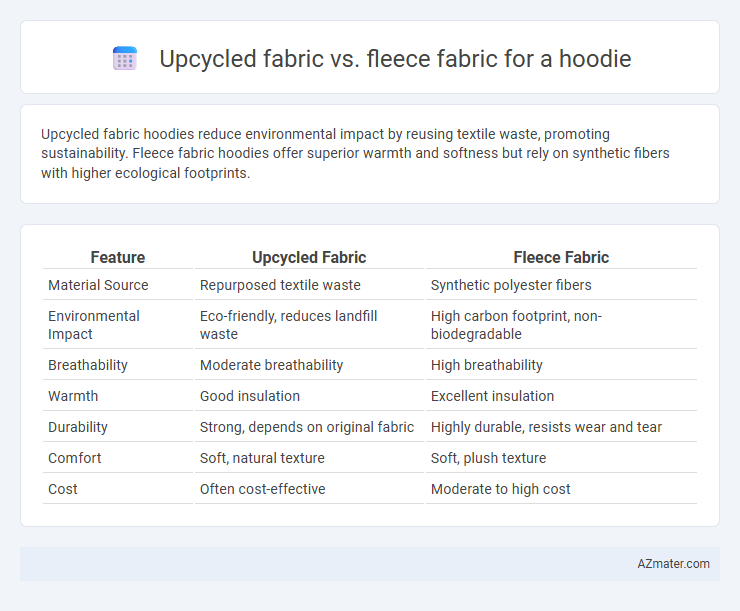Upcycled fabric hoodies reduce environmental impact by reusing textile waste, promoting sustainability. Fleece fabric hoodies offer superior warmth and softness but rely on synthetic fibers with higher ecological footprints.
Table of Comparison
| Feature | Upcycled Fabric | Fleece Fabric |
|---|---|---|
| Material Source | Repurposed textile waste | Synthetic polyester fibers |
| Environmental Impact | Eco-friendly, reduces landfill waste | High carbon footprint, non-biodegradable |
| Breathability | Moderate breathability | High breathability |
| Warmth | Good insulation | Excellent insulation |
| Durability | Strong, depends on original fabric | Highly durable, resists wear and tear |
| Comfort | Soft, natural texture | Soft, plush texture |
| Cost | Often cost-effective | Moderate to high cost |
Introduction to Upcycled and Fleece Fabric Hoodies
Upcycled fabric hoodies are crafted from reclaimed textile materials, significantly reducing waste and environmental impact through sustainable production practices. Fleece fabric hoodies, made from synthetic fibers like polyester, provide exceptional warmth and softness, making them ideal for cold weather comfort. Choosing between upcycled and fleece hoodies involves balancing eco-conscious material reuse against performance-focused insulation benefits.
What is Upcycled Fabric?
Upcycled fabric is created by repurposing existing textile materials, reducing waste and environmental impact by transforming discarded fabrics into new, usable materials. Unlike fleece fabric, which is typically made from synthetic fibers like polyester and involves energy-intensive production processes, upcycled fabric supports sustainable fashion practices by minimizing resource consumption. Hoodies made from upcycled fabric offer eco-friendly alternatives without compromising on quality or comfort.
What is Fleece Fabric?
Fleece fabric is a soft, warm, and lightweight synthetic material typically made from polyester fibers, designed to provide excellent insulation and moisture-wicking properties in hoodies. It is popular for its durability and ability to retain heat even when wet, making it ideal for cold-weather apparel. Compared to upcycled fabric, fleece offers consistent texture and performance but often involves higher environmental impact due to its synthetic production process.
Environmental Impact: Upcycled vs Fleece
Upcycled fabric for hoodies significantly reduces environmental impact by repurposing existing materials, minimizing textile waste, and lowering carbon emissions compared to virgin fabric production. Fleece fabric, often made from polyester derived from fossil fuels, contributes to microplastic pollution and higher energy consumption during manufacturing. Choosing upcycled hemp or cotton blend fabrics supports sustainable practices by conserving resources and promoting circular fashion.
Comfort and Wearability Comparison
Upcycled fabric hoodies offer superior breathability and moisture-wicking properties, making them ideal for comfortable all-day wear. Fleece fabric provides exceptional warmth and softness but may cause overheating in mild conditions due to limited airflow. Both materials vary in durability, with upcycled fabric often featuring unique textures, while fleece excels in retaining insulation during colder weather.
Durability and Longevity
Upcycled fabric hoodies often feature unique, reinforced fibers that enhance durability by repurposing high-quality textile scraps, making them environmentally sustainable while maintaining strength. Fleece fabric, known for its soft texture and thermal insulation, offers excellent longevity with resistance to pilling and stretching, ideal for activewear hoodies. Choosing between upcycled and fleece fabrics depends on whether you prioritize eco-friendly durability or consistent softness combined with long-lasting wear.
Cost and Affordability
Upcycled fabric hoodies generally offer a more affordable and sustainable option compared to fleece fabric, as they reuse existing materials, reducing production costs and environmental impact. Fleece fabric, made from synthetic fibers like polyester, often involves higher manufacturing expenses and energy consumption, leading to increased retail prices. Consumers prioritizing budget and eco-friendliness find upcycled fabric hoodies a cost-effective and environmentally responsible choice.
Style and Design Possibilities
Upcycled fabric offers unique patterns and textures, making each hoodie one-of-a-kind, ideal for consumers seeking eco-friendly and distinctive style statements. Fleece fabric provides consistent softness and warmth with a smooth surface, allowing for sleek, minimalist designs and vibrant color options. Combining upcycled materials with fleece elements can create innovative hoodies that balance sustainability with classic comfort and contemporary aesthetics.
Maintenance and Care
Upcycled fabric hoodies require gentle washing with mild detergents to preserve the varied textures and colors from reclaimed materials, often benefiting from cold water cycles and air drying to prevent shrinkage and wear. Fleece fabric hoodies offer easier maintenance, as they are machine washable and dry quickly, though avoiding high heat and fabric softeners is crucial to maintain softness and prevent pilling. Both fabrics demand specific care routines to prolong durability, but fleece's synthetic composition generally allows for more straightforward and durable maintenance compared to the delicate nature of upcycled textiles.
Which Hoodie Fabric is Right for You?
Upcycled fabric hoodies offer eco-friendly benefits by repurposing textile waste, making them ideal for sustainable fashion enthusiasts seeking unique, environmentally conscious clothing. Fleece fabric hoodies provide exceptional warmth, softness, and moisture-wicking properties, perfect for active lifestyles and colder climates. Choosing between upcycled fabric and fleece depends on your priorities: sustainability and uniqueness versus comfort and thermal performance.

Infographic: Upcycled fabric vs Fleece fabric for Hoodie
 azmater.com
azmater.com